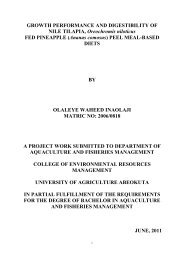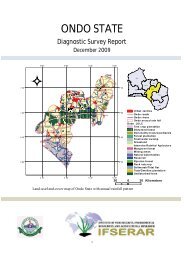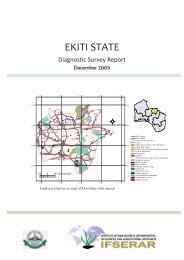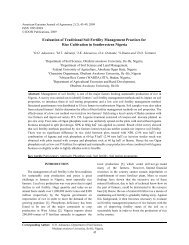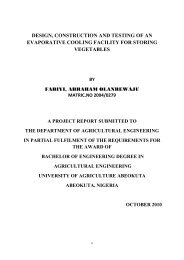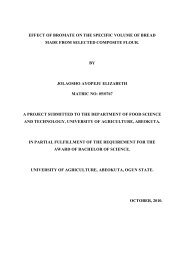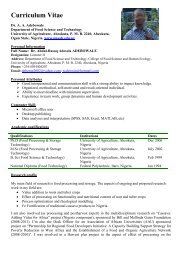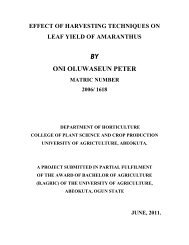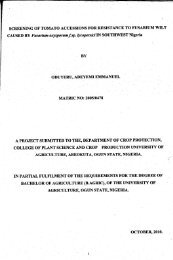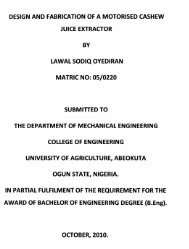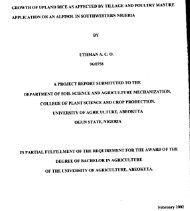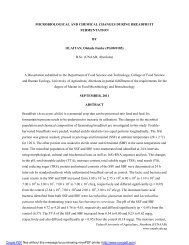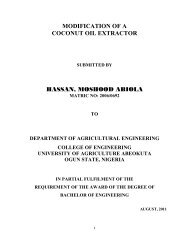TRANSMISSION OF COWPEA APHID BORNE MOSAIC VIRUS ...
TRANSMISSION OF COWPEA APHID BORNE MOSAIC VIRUS ...
TRANSMISSION OF COWPEA APHID BORNE MOSAIC VIRUS ...
Create successful ePaper yourself
Turn your PDF publications into a flip-book with our unique Google optimized e-Paper software.
<strong>TRANSMISSION</strong> <strong>OF</strong> <strong>COWPEA</strong> <strong>APHID</strong> <strong>BORNE</strong> <strong>MOSAIC</strong><br />
<strong>VIRUS</strong> (CABMV) (genus potyvirus, family potyviridae) IN THE<br />
SEED <strong>OF</strong> <strong>COWPEA</strong><br />
(Vigna unquiculata L. Walp) PLANTS.<br />
BY<br />
BANKOLE, IDRIS ADEBISI<br />
MATRIC NO: 2004/0714<br />
DEPARTMENT<br />
<strong>OF</strong> CROP PROTECTION<br />
COLLEGE<br />
<strong>OF</strong> PLANT SCIENCE AND CROP PRODUCTION<br />
UNIVERSITY <strong>OF</strong> AGRICULTURE, ABEOKUTA, OGUN STATE,<br />
NIGERIA.<br />
A PROJECT SUBMITTED IN PARTIAL FULFILLMENT <strong>OF</strong> THE AWARD <strong>OF</strong><br />
BACHELOR <strong>OF</strong> AGRICULTURE, (B. AGRIC.) <strong>OF</strong> THE UNIVERSITY <strong>OF</strong><br />
AGRICULTURE,<br />
ABEOKUTA, OGUN STATE, NIGERIA.
.....'1.f.~r?.lll.l.<br />
Date<br />
.t:J.7..1..I~ l~ ("<br />
Date
I dedicate this project to Almighty ALLAH, who through Ramah guard and guided me<br />
through my entire stay in UNAAB. I also dedicate it to the memory of my beloved Dad, Alh.<br />
A.A Bankole whom there can never be any replacement for, and to my dear Mum, Alhaja<br />
.A.O Bankole whom asides ALLAH has been the pillar behind my pole.
All praises and adoration is due to Almighty Allah (S.W.T), the Giver and Sustainer, Who<br />
through His infinite mercy had made this project an easy task for that I am sincerely<br />
grateful.<br />
I want to appreciate the effort of my supervisor Dr. A.A. Fajimi, who through his<br />
constructive criticism made this project an easy one for me, I pray Allah (S.W.T.) make your<br />
entire task an easy one for you. I will like to thank my Head of Department,<br />
Dr. O.R. Pitan<br />
and all other lecturers in the department; you've all made a great impact in my life.<br />
My unquantifiable thanks goes to my channels to this world, firstly my Late father, Alhaji<br />
A.A. Bankole who did everything possible to save us from the hardship of this world and<br />
hereafter, Dad you are second to none and I'll forever miss you, also to my Mum (Iya Idris),<br />
who despite all odds still manage to see us all through our various ambition at every stage of<br />
our lives, I pray you live to do more and abundantly<br />
rip the fruit of your labour. To all my<br />
siblings I am saying a very big thanks to you all, no need to mention your names because<br />
there can never be anyone in this world that will share those precious name with you in my<br />
heart, thanks for the support, I sincerely appreciate it.<br />
My special thanks goes to the Imam of this University Dr. LA. Ayinde who made me move<br />
on at those periods when I thought I could not do it again, I don't know how much to<br />
appreciate your effort on me, thank you very much. To all associations I belonged to<br />
especially M.S.S.N and Muslim Contact Forum (M.C.F.) thank you for adding to my spiritual<br />
well-being.<br />
Lastly to all my friends who had made an impact such as Hammed Adebayo (you remain the<br />
best), Matanmi Ibrahim, Muideen Raheem, Onibon Kazeem, Damola Agboola, Tunji
,<br />
~.,<br />
iAdeY
~~"<br />
l,<br />
~~;<br />
Cowpea (Vigna unquiculata L. Walp) is an economically important leguminous crop in<br />
r<br />
Nigeria and several other countries of the world. Among the disease that affects cowpea,
Certification<br />
Dedication<br />
Acknowledgement<br />
Abstract<br />
Table of Content<br />
List of Table<br />
List of plates<br />
CHAPTER ONE<br />
INTRODUCTION<br />
1.1 Cowpea Virus Diseases<br />
1.1.1 Economic Importance of Viral Diseases of Cowpea<br />
1.2 Objective of the study<br />
CHAPTER TWO 4<br />
2.0 LITERATURE REVIEW 4<br />
2.1 Diseases of Cowpea 4<br />
2.1.1 Incidence of viral diseases on cultivated cowpea 4<br />
2.1.3 Cowpea aphid borne mosaic virus (CABMV) 5<br />
2.2 Spread of viral Diseases on Cultivated Cowpea 5<br />
2.3 Management ofCABMV Diseases of Cowpea 6
3.0 MATERIALS AND METHOD 7<br />
3.1 Experimental site 7<br />
3.2 Materials used 7<br />
3.3 Mechanical inoculation 7<br />
3.3.1 Procedure for mechanical inoculation 8<br />
3.4 Procedure for the separation of seed coat from the cotyledon 8<br />
3.4.1 Seed coat and cotyledon test 9<br />
3.5 Serological assay procedure using ACP-ELISA 9<br />
3.5.1 Virus detection 9<br />
3.5.2 Virus Indexing Protocol 10<br />
CHAPTER FOUR<br />
4.0 RESULTS<br />
CHAPTER FIVE<br />
5.0 DISCUSSION<br />
5.1 CONCLUSION<br />
5.2 RECOMMEDATION<br />
REFERENCES
TABLE 1: Detection of CABMV by ACP-ELISA in the cotyledon, seed coat and leaves of<br />
I';<br />
grown out seedlings in ten varieties of cowpea 15
Cowpea (Vigna unquiculata L. Walp) is an important leguminous crop in tropical and subtropical<br />
areas of Asia, Africa and Latin America, as well as parts of southern Europe and the USA (Singh et<br />
al., 1997; Boukar et al., 2004). It was estimated that 3.3 million tonnes of cowpea dry grains were<br />
produced world-wide in year 2000. Nigeria produced 2.1 million tonnes of this, making it the<br />
world's largest producer, followed by Niger (650,000 tonnes) and Mali (110,000 tonnes) (IITA,<br />
2004; Adegbite et el, 2008). According to FAO, about 7.56 million tonnes of cowpea are produced<br />
worldwide annually on about 12.76 million hectares. Sub-Saharan Africa accounts for about 70% of<br />
total world production (lIT A, 2009). Cowpea also provides a significant dietary protein of the people<br />
and plays an important role in the nutritional role in developing countries of the tropics, subtropics,<br />
especially sub-Saharan Africa ( Rachie, 1985, singh et el.,). It provides high protein and lysine<br />
contents make cowpea a natural supplement to staple diets of cereals, roots and tubers commonly<br />
grown in many poor countries (Bressani, 1985; Adekola et el, 2007). Cowpea young leaves and pod<br />
contains vitamins and minerals which have fuelled it's usage for human consumption and animal<br />
feeding.( Rachie, et el., 1985;Nelson,1997). Cowpea is a common food crop throughout Nigeria but<br />
particularly in the middle belt and drier northern regions also in Nigeria cowpea is used to make<br />
soups and bean mixes such as moi- moi and beans cake. The leaves may be boiled, drained, sun<br />
dried, and then stored for later use. (Duke 1981) All of these factors make cowpea a vital crop to<br />
millions of poor people. Cowpea is susceptible to a number of fungal, bacterial, and viral diseases.<br />
Of more than twenty viruses reported on cowpea from different areas of the world, eight are known<br />
to occur in cowpea in Africa (Mali and Thottappilly, 1986; Brunt et al., 1990). Passage of viral<br />
inoculum from diseased plants to their offspring was long thought to be a rare phenomenon. Today,<br />
seed transmission is known to occur for about one-seventh of the known viruses in one or more of
their hosts (Hull, 2002), and the number is increasing. Three important effects of seed transmission<br />
are: (i) direct and/or indirect injury, as even a low incidence of infected seeds sown results in<br />
numerous randomly scattered foci of inoculum, facilitating early secondary spread in the crop<br />
vectors, (ii) survival of viral inoculum<br />
from one crop season to the next; and (iii) several viruses and<br />
viroids have been, and undoubtedly still are, disseminated worldwide through exchange of seeds<br />
having undetected infection (Albrechtsen, 2006).<br />
1.1 Cowpea Virus Diseases<br />
Over 140 viruses have been reported worldwide to infect cowpea cultivars but only nine have been<br />
reported in Nigeria, and these are Cowpea aphid-borne mosaic virus (CABMV), genus Potyvirus;<br />
Cowpeagolden mosaic virus (CPGMV),<br />
genus Bigeminivirus; Southern bean mosaic virus (SBMV),<br />
genus Sobemovirus; Sunhemp mosaic virus (SHMV), genus Tobamovirus; Blackeye mosaic virus<br />
(BICMV), genus Potyvirus; Cucumber mosaic virus (CMV), genus Cucumovirus; Cowpea mottle<br />
virus (CMeV), genus Carmovirus; Cowpea yellow mosaic virus (CPMV)<br />
genus, Comovirus; Cowpea<br />
mild mottle virus (CPMMV), genus Carlavirus. (Shoyinka, 1974; Hughes et aI2003).<br />
During some seasons,<br />
plants may be infected with only one virus, while in the other seasons plants<br />
are infected with a combination of viruses. Both quality and quantity of yield can be significantly<br />
reduced in severely infected field (Mali and Thottapilly, 1986 ).<br />
Transmission of plant viruses could either be persistent or non-persistent manner (Lana<br />
andAdegbola; 1997). Aphid borne viruses that are transmitted non-persistently are most abundant and<br />
wide spread of all known plant viruses. They comprise of several taxonomic group represented by<br />
the following genera; Potyvirus, calavirus, Alfamovirus, Fabavirus, Caulimovirus and Cucumovirus,<br />
(Lana andAdegbola; 1997).
The majority of the viral diseases of cowpea lead to overall stunting, reduction in leaf size, mottling,<br />
mosaic, leaf chlorosis, leaf distortion, leaf curling, vein clearing, necrotic local lesion and death<br />
(Akinjogunla, 2005).<br />
1.1.1 Economic Importance of Viral Diseases of Cowpea<br />
The effects of viruses can be devastating and are a major constraint to the production of cowpea<br />
(Thottappilly and Rossel, 1992). Resultant effect of cowpea viral diseases such as poor pod<br />
formation and quality has been a major constraint in cowpea production in most part of the world.<br />
Diseases of plant viruses affect some parts of cowpea plants including<br />
the leaves, foliage, pods and<br />
young seedlings. (Thottappilly and Rossel, 1992).<br />
The production of cowpea is constrained by a vast array of pathogenic organism and insect. Infection<br />
can result in loss of saleable produce from the plant .Infection by several viruses occurs in cowpea<br />
production which reduces its yield and quality of pod. (Lovisolo et el., 1966)<br />
1.2 Objective of the study<br />
To investigate seed transmission of cowpea aphid-borne mosaic virus (CABMV) in seed coat and<br />
cotyledon of cowpea.
CHAPTER TWO<br />
2.0 LITERATURE REVIEW<br />
2.1 Diseases of Cowpea<br />
Viral diseases of cowpea (Vigna unguiculata), varies in terms of the severity depending on host<br />
cultivar and virus strain. (Aboul-Ata et al 1982). Diseased cowpea plants show variable amounts of<br />
dark green vein banding or interveinal chlorosis, leaf distortion, blistering and stunting (Van<br />
Kammen, 1973). Viruses that may be related cause mosaic diseases of adzuki bean (Phaseolus<br />
angu/aris) and asparagus bean (Vsesquipedalis). (Adegbite, and Amusa, 2008).<br />
2.1.1 Incidence of viral diseases on cultivated cowpea<br />
Cowpea is greatly attacked by wide array of diseases of biological origin especially viruses which<br />
cause devastating effects and are a real constraint to increased yield of cowpea in several countries<br />
(Brunt,et el 1990).<br />
Of all the known viruses of cowpea, cowpea aphid-borne mosaic virus is responsible for the major<br />
viral disease of cowpea in Nigeria (Shoyinka et aI., 1997). In reference to a three year survey for the<br />
incidence and distribution of cowpea viruses, detected viruses in 390 out of 649 cowpea collected<br />
from all agro ecological zones in Nigeria using ELISA, CABMV had the highest incidence and was<br />
the most prevalent of all the virus detected, (Shoyinka et aI., 1997).<br />
2.1.2 Symptoms of viral diseases of cowpea<br />
The majority of the viral diseases of cowpea lead to overall stunting, reduction in leaf size, mottling,<br />
mosaic, leaf chlorosis, leaf distortion, leaf curling, vein clearing, necrotic local lesion and death<br />
(Akinjogunla, 2005). Typical symptoms of viral infections are stunting, mottling or foliage and<br />
deformed pod.
2.1.3 Cowpea aphid borne mosaic virus (CABMV)<br />
Cowpea aphid borne mosaic virus (CABMV), a member of the Potyvirus genus, a distinctive virus<br />
with flexuous filamentous particles c. 750 nm long. It is seed-borne in cowpea, has a wide<br />
experimental host range, is transmitted by several common species of aphid, and occurs in many<br />
countries where cowpea is grown, (Bock, 1974)<br />
It causes a severe mosaic of cowpea (Vigna unguiculata), the severity depending on host cultivar and<br />
virus strain. Diseased cowpea plants show variable amounts of dark green vein banding or<br />
interveinal chlorosis, leaf distortion, blistering and stunting, (Thottapilly and Rossel, 1992) Viruses<br />
that may be related cause mosaic diseases of adzuki bean (Phaseolus angularis) and asparagus bean<br />
(V. sesquipedalis), (Tsuchizaki et al 1970). It occurs in Africa (Kenya, Uganda and Nigeria), Europe<br />
(Italy, and probably Rumania), and Asia (India, Iran, Japan, and probably China). Viruses that are<br />
probably related occur in the USA (Florida) and in the south-west<br />
Pacific area, (Bock et aI1974).<br />
It can cause a yield loss of 13 - 87% under field conditions depending upon crop susceptibility, virus<br />
strain and the environmental conditions, (Bashir,et el,1996). CABMV has spread world-wide<br />
through the exchange of virus-infected germplasm material. The virus-infected seed provides the<br />
initial inoculums and aphids are responsible for the secondary spread of the disease under field<br />
conditions, (Taiwo, 2003). The virus symptoms vary with the cowpea genotype and virus strain.<br />
Excellent sources of resistance are available for the breeding of resistant cultivars. Resistance in<br />
cowpea is conferred by either a dominant or a recessive gene. (Thottapilly and Rossel, 1992).<br />
2.2 Spread of viral Diseases on Cultivated Cowpea<br />
Viruses can be transmitted by insects, primarily Aphids, leafhoppers, and thrips, sometimes<br />
whiteflies can transmit viruses. Mites, fungi and nematodes can occasionally transmit viruses (Bock<br />
et el 1974). However, there are two types of viral transmission which could be persistent or nonpersistent.<br />
By a vector, the virus is transmitted in the stylet-borne, non-persistent manner by Aphis
craccivora (Bock, 1973), A. fabae, A. gossypii, A. medicaginis, Macrosiphum euphorbiae and Myzus<br />
persicae (Vidano, 1965). Non-feeding aphids can retain infectivity up to 15 h after virus acquisition.<br />
Seed transmission is usually slight (0-3 %) but instances of21.5% have been recorded in cowpea cv.<br />
Kurodane 16 for a virus which resembles<br />
the type strain and 14.7% for a virus which may be related,<br />
adzuki bean mosaic (Tsuchizaki et al 1970). Seed transmission ranged from 3 to 19% in cv. Pusa<br />
Phalguni for an Indian isolate serologically related to the African (neo-type) virus (Tsuchizak et al<br />
1970). Plants infected through the seed show bright mosaic symptoms in primary leaves.<br />
2.3 Management of CABMV Diseases of Cowpea<br />
Different control methods techniques have been employed to reduce CABMV disease incidence on<br />
cultivated cowpea. Remove any disease seedling that show symptoms of the disease and place them<br />
in a refuse pile away from cowpea production field (Thottapilly and Rossel, 1992). Planting dates<br />
can be used as an effective tool for disease management by alternating the planting ages and planting<br />
dates for the particular variety grown in order to denaturalize inoculums transfer by vectors<br />
(Thottapilly and Rossel, 1992). Scouting and monitoring fields for aphids and disease symptoms<br />
regularly can be carried out (Conti et el 1974). Control methods<br />
should not be limited to the use of<br />
cultivars with resistance to diseases, pathogen-free seeds, sterilized equipment for transplant<br />
production, rouging, eradication of diseased plants and alternate hosts, but also experimenting with<br />
environmental variables such as time of planting. (Crastree et a/1990.)<br />
Early weed control, application of registered insecticides at least regularly at recommended dosage<br />
may reduce aphids and the feeding damage they cause. Control of viruses by insects can be reduced<br />
by the destruction of old infected crops well before planting subsequent crops beside alongside them.<br />
(Thottapilly and Rossel, 1992)
ț<br />
['<br />
r Ten varieties of Cowpea namely: (IT90K-227-2, TVX 3236, IFE 98-12, ERUSU, MODUPE, ZOBO,
{3A.<br />
~<br />
~3.IJ. Procedure of mechanical inoculation<br />
"easy access of virus into the leaf cells. 600 meshes carborandum<br />
E<br />
powder dusted on each marked leaf.<br />
[. sterilized swab was dipped into the CABMV sap extract gotten from the ground CABMV infected<br />
~pt;and each dusted leaf was stroked from the petiole to the leaf tip with one hand while the other<br />
f band supported the leaf. Five strokes of the CABMV saturated with cotton swab were made on each<br />
~,marked leaf and the inoculums in the pad were renewed frequently. Heavy pressure was avoided and<br />
the same area was not gone over twice.
7 The plates were emptied and tap plate dried then 100ml per well of antibody (monoclonal or<br />
'polyclonal) was diluted in conjugate buffer 1:5000. The plates were covered and incubated at 37°C<br />
f<br />
: O.Olgofp-nitro phenyl phosphate substrate was added to 10ml of substrate buffer.<br />
~" For all incubations,<br />
~<br />
plates were covered with ELISA cover plates to avoid edge effect and to<br />
f.
f biotechnological laboratory in a zip bag for serological assay using ACP-ELISA, to confirm the<br />
~<br />
f: presence of CABMV.<br />
/. 3. Grown out test<br />
t.<br />
~.The third experiment involved plating out of two seeds of each variety of the cowpea used in a<br />
R'<br />
r sterilized covered Petri-dishes during it's early period of growth in three replicates inside the tissue
CHAPTER FOUR<br />
RESULT<br />
In the first experiment (Seed coat and cotyledon assay), CABMV was detected in the cotyledons in<br />
'all the ten varieties of seeds analyzed serologically with ACP-ELISA. In contrast, the virus could not<br />
,be detected in the seed coat of all the ten varieties of seeds analyzed.<br />
While in the second experiment<br />
(Tissue culture), all the leaves that were harvested from the cotyledons of the cowpea varieties that<br />
.'were cultured in a Murashige and Skoog basal medium all tested positive to CABMV when analyzed<br />
logically. Similarly, in the third experiment (Grown out test), all the leaves that were harvested<br />
from the seeds germinated on the sterilized moistened filter paper in a sterilized Petri-dish all tested<br />
,positive to CABMV when they were analyzed serologically with ACP-ELISA. This helped in<br />
confirming that the virus was associated with the cotyledon of the cowpea seed.
TABLE 1: DETECTION <strong>OF</strong> CABMV BY ACP - ELISA IN THE COTYLEDON, SEED COAT<br />
AND LEAVES <strong>OF</strong> GROWN OUT SEEDLINGS IN TEN VARIETIES <strong>OF</strong> <strong>COWPEA</strong><br />
VARIETY COTYLEDON SEEDCOAT GROWN OUT SEEDLINGS<br />
2 3 2 3 2 3<br />
OLOYIN + + + + + +<br />
MODUPE + + + + + +<br />
IT 90K-227-2 + + + + + +<br />
ERUSU + + + + + +<br />
IFE 98-14 + + + + + +<br />
TVX 328 + + + + + +<br />
MALLAM + + + + + +<br />
ZOBO + + + + + +<br />
SOKOTO + + + + + +<br />
DRUM + + + + + +<br />
KEY<br />
+= INFECTED<br />
- = UNINFECTED
"transmission in a non-persistent manner, which was also exhibited by CABMV. The frequency of<br />
J<br />
r seed transmission for plant viruses varies from 0 to 100% and rarely exceeds 50%for most of the<br />
~.<br />
~<br />
i viruses.<br />
f
it had been confirmed in this experiment that CABMV is seed borne and can be transmitted<br />
seed farmers are thereby advised to screen seeds before sowing them so as to obtain a virus<br />
teed to reduce the impact of the CABMV.
REFRENCES<br />
Adegbite, A.A. and Amusa, N.A. 2008. The major economic field diseases of cowpea in the humid<br />
agro ecologies of South-Western Nigeria. Africanjournal of Biotechnology 7:4706-4712.<br />
Akinjogunla OJ (2005). Effects of single and mixed inoculation with viruses on symptomatology,<br />
growth, yield and nutritive content of cowpea: (Vigna unquiculata) M.Sc. Thesis.<br />
University of Lagos, Nigeria .<br />
. . Albrechtsen, S.E. 2006. Testing methods for seed transmitted viruses: Principles and protocols.<br />
CABL Publishing Oxfordshire, UK 259pp.<br />
Bashir M, Hampton RO (1996). Detection and identification of seedborne viruses from cowpea<br />
(Vigna unquiculata (L.) walp) germplasm. Plant Pathol. 45: 54-58.<br />
Bressani, R 1985. Nutritive value of cowpea. In cowpea research, production and utilization. Singh,<br />
S.R., Rachie, K.O. (Eds.), pp. 353-359. John wiley and sons,U.K.<br />
Brunt, A. Crastree,<br />
K. and Gibbs, A. 1990. Viruses of Tropical Plants Oxon, UK: LAB Inter.<br />
Converse<br />
Bock KR (1973). African strains of cowpea aphid-borne mosaic viruses Ann. Appl. BioI. 74: 175-<br />
183.<br />
Bock KR, Conti M (1974). Cowpea aphid-borne mosaic virus CMI/AAB. Description of plant<br />
viruses No. 134. Kew, Surrey,England.<br />
Duke JA (1981). Handbook of Legumes of World Economic Importance. Plenum press, New York<br />
pp.345.<br />
Fajinmi, A. A., 1995: Studies on pepper veinal mottle Poty virus disease of pepper (
Hughes JOA, Shoyinka SA (2003). Overview of viruses of legumes other than groundnut in Africa<br />
in Plant virology in sub-Saharan African, Proceeding of Plant Virology, UTA, Ibadan,<br />
Nigeria. Eds Hughes JOA, Odu. B. pp 553-568.<br />
Hughes J.d' A. and Thomas, BJ. 1988. The use of protein A-sandwich ELISA as a means of<br />
quantifying serological relationships between members of the tobamovirus group. Annals of<br />
Applied Biology 112: 117-126.<br />
Hull, R. 2002. Matthews Plant virology, 4th edn, Academic Press, London, UK.<br />
lITA, Ibadan, Nigeria. pp. 270-273. Shoyinka SA, Thottapilly G, Adebayo GG, Anko-Nyoko FO<br />
(1997).<br />
UTA, Ibadan Nigeria eds. Hughes JDA, Odu B, pp 364-378. Taiwo MA, Akinjogunla OJ (2006).<br />
Cowpea Viruses: Quantitative and qualitative effect of single and mixed viral infection. Afr.<br />
J. Biotechnol. 5.<br />
Johansen, E., Edwards, M. c., and Hampton, R. O. 1994. Seed transmission of viruses: Current<br />
perspectives.<br />
Annu. Rev. PhytopathoI.32:363-38<br />
International Institute of Tropical Agriculture (UTA) 2009. lIT A Cereals and Legume Systems.www.<br />
i ita.<br />
0 rg/cms/details/cowpea_project_details.asp<br />
Ladipo L. 1977. Seed Transmission<br />
of Cowpea aphid borne mosaic virus in some cowpea cultivars.<br />
Nigerian Journal<br />
of Plant Protection<br />
Ladipo JL (1976). A vein banding strain of cowpea aphid-borne mosaic virus in Nigeria.<br />
Lana AF, Adegbola MO (1997). Important Virus diseases in West African Crops. Rev. Plant Pathol.<br />
Lovisolo 0, Conti M (1966): Identification of an aphid transmitted cowpea virus in Netherlands. J.<br />
Plant Pathol.<br />
Mali, V.R. and Thottappilly, G. 1986. Virus diseases of Cowpea in the Tropics. In: Raychadhuri, S.P.<br />
and Verma, J.P. (Eds.). Reviews of Tropical Plant Disease 3:361-403
Maury, Y., Bossennec, J. M., Boudazin, G., Hampton, R., Pietersen, G., and Maguire,J. 1987.<br />
Factors influencing ELISA evaluation of transmission of pea seed-borne mosaic virus in<br />
infected pea seed: seed-group size and seed decortication. Agronomie 7:225-23<br />
Mink, G. I. 1993. Pollen- and seed-transmitted viruses and viroids. Annu. Rev. PhytopathoI.31 :375-<br />
402.<br />
Pahalawatta, V., Druffel, K., and Pappu, H. R. 2007. Seed transmission of Dahlia mosaic virus in<br />
Dahlia pinnata. Plant Dis. 91 :88-91..<br />
Pundt, L., 2002 : Halt viruses. Grower Talks<br />
Rachie K.O (1985). Introduction of cowpea research, production and utilization, edicted by singh<br />
SR, Rachie John Wiley & sons, Chichester<br />
UK.<br />
Robertson DG (1966). Seed-borne viruses in cowpea in Nigeria. B. Sc. Thesis University of Oxford,<br />
U.K.<br />
Shoyinka SA (1974). Status of viral diseases of cowpea in Nigeria, in proceedings of the first IlTA<br />
grain legume improvement<br />
workshop.<br />
Shoyinka, S.A., Thottappilly, G., Adebayo, G.G.and Anno-Nyako, F.O. 1997. Survey on cowpea<br />
virus incidence and distribution in Nigeria. International Journal of Pest. Management<br />
Singh, B.B., Chambliss, O.L. and Sharma, B. 1997. Recent advances in cowpea breeding.In: B.B.<br />
Singh et aI. (Ed.), pp. 30-49. Advances in cowpea research. Copublication ofIlTA and<br />
JIRCAS. International Institute of Tropical Agriculture, Ibadan, Nigeria.<br />
Singh, S. R. and Allen D. J. 1980. Cowpea pests and diseases. International<br />
Institute of Tropical<br />
Agriculture<br />
Manual series NO 2IlT A Ibadan Nigeria.<br />
Taiwo MA (2003). Viruses infecting<br />
legumes in Nigeria: case history. In plant virology<br />
sub-Sarahan Africa. Proceedings of Plants Virology.<br />
Thottapilly<br />
G, Rossel HW (1992). Virus of cowpea in tropical Africa. Trop. Pest Manage.<br />
Tsuchizaki Yora and Asuyam Ann. phytopath. Soc. Japan, 1970a
Van kammen CM/lAAB Descriptions of Plant Viruses 47CM/lAAB Descriptions of Plant Viruses 47<br />
Vidano & Conti, Atti. Accad. Sci. Torino 99: 1041, 1965.



